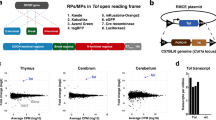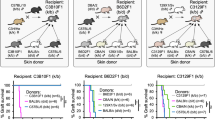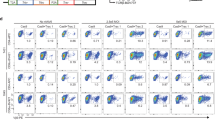Abstract
BOTH synergistic and antagonistic effects of immunization with multiple antigens have been reported in general immunology. The same has been difficult to examine in transplantation immunity because the frequently used strains of mice usually differ by multiple antigenic factors, including those controlled by the ‘strong’ H-2 locus. (Reference to gene ‘strength’ in the present context pertains to the effects of the antigenic products of the particular gene on graft survival and should not be confused with the more common genetic use of the word to indicate relative dominance or recessiveness. All known histocompatibility genes are dominant.) With strains differing by the antigens of one and two weak genetic factors it was possible to demonstrate shorter graft survival when two incompatibilities were present. The mice used were progeny of pedigreed pairs obtained from George Snell of Bar Harbor, Maine1,2, and were the products of brother–sister matings carried out in such a way that no experimental mice were more than two generations apart. The strains used, along with their genetic relationships, are shown in Table 1. It will be noted that the three strains are identical at the H-2 locus, that B10 and B10.129 (5M) differ only at H-1, that B10 and B10LP differ only at H-3 and that B10.129 (5M) and B10.LP differ at both H-1 and H-3.
This is a preview of subscription content, access via your institution
Access options
Subscribe to this journal
Receive 51 print issues and online access
$199.00 per year
only $3.90 per issue
Buy this article
- Purchase on Springer Link
- Instant access to full article PDF
Prices may be subject to local taxes which are calculated during checkout
Similar content being viewed by others
References
Snell, G. D., J. Nat. Cancer Inst., 21, 843 (1958).
Snell, G. D., and Stevens, L. C., Immunol., 4, 366 (1961).
Billingham, R. E., and Medawar, P. B., J. Exp. Biol., 28, 385 (1951).
Möller, G., J. Nat. Cancer Inst., 30, 1153 (1963).
Author information
Authors and Affiliations
Rights and permissions
About this article
Cite this article
McKHANN, C. Additive Effect of Multiple Weak Incompatibilities in Transplantation Immunity. Nature 201, 937–938 (1964). https://doi.org/10.1038/201937a0
Issue Date:
DOI: https://doi.org/10.1038/201937a0
This article is cited by
-
Genetic control of minor histocompatibility antigens in the mouse
Survey of Immunologic Research (1984)
-
Cell-mediated hyperacute rejection
Immunogenetics (1981)
-
Genetics of histocompatibility in mice
Immunogenetics (1980)
-
A qualitative difference between certain H-2 and Non-H-2 antigens responsible for a similar graft-rejection rate
Experientia (1967)
Comments
By submitting a comment you agree to abide by our Terms and Community Guidelines. If you find something abusive or that does not comply with our terms or guidelines please flag it as inappropriate.



